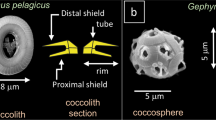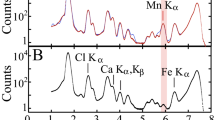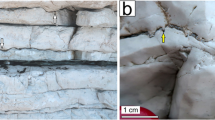Abstract
Reactions occurring on the surfaces of biogenic carbonate minerals can have important consequences for the biogeochemical cycle of carbon. In this study, carbonate mineral surface reactions with ambient seawater were investigated by atomic force microscopy (AFM). A sampling method was developed in which calcite surfaces were hung at discrete depths on a sediment trap array line for a three-day deployment period in subtropical North Pacific waters. Changes in surface morphologies were examined at nanometer resolution and evaluated using as a constraint the depth profile of calcite saturation in these waters. Evidence suggests that: (1) organic films which develop on carbonate surfaces exposed to shallow seawater may be responsible for the oversaturated state of the upper oceanic water column, (2) dissolution of carbonate minerals within the shallow warm layer of the ocean could be responsible for part of the alkalinity anomaly observed in the North Pacific.
Similar content being viewed by others
References
Arakawa H., Umemura K. and Ikai A. (1992) Protein images obtained by STM, AFM and TEM. Nature 358, 171–173.
Berger W. H. (1967) Foraminifera ooze: Solution at depth. Science 156, 83–385.
Berner R. A. (1975) The role of magnesium in the crystal growth of calcite and aragonite from seawater, Geochim. Cosmochim Acta 39, 489–504.
Berner R. A., Westrich J. T., Graber R., Smith J. and Martens C. S. (1978) Inhibition of aragonite precipitation from super saturated seawater: A laboratory and field study. Amer. J. Sci. 73, 3315–3321.
Betzer P. R. (1984) The oceanic carbonate system: A reassessment of biogenic control. Science 226, 1074–1077
Broecker W. S. (1974) Chemical Oceanography, Harcourt Brace Jovanovich, NY, 214 pp.
Broecker W. S. and Peng T. H. (1972) In: Tracer in the Sea, Columbia University, New York, 690 pp.
Bingham F. and Lukas R. (1994) The southward intrusion of North Pacific Intermediate water along the Mindanao Coast. submitted to J. Phys. Oceanogr.
Binning G. Quate C., and Gerber C. (1986) Atomic force microscope. Phys. Rev. Lett. 56, 930–933.
Broecker W. S. and Takahashi T. (1978) The relationship between lysocline and in situ carbonate ion concentration. Deep-Sea Res. 25, 65–95.
Chave K. E. and Suess E. (1967) Suspended minerals in seawater. N. Y. Acad. Sci. Trans. 29, 991–1000.
Chen C. T. A. and Pytkowicz R. M., 1979, On the total CO2-titration alkalinity-oxygen system in the Pacific Ocean. Nature 281, 362–356.
Dickson A. (1984) pH scales and proton-transfer reactions in saline media such as seawater. Geochim. Cosmochim. Acta 48, 2299–2308.
Dove P. M. and Hochella, M. F. (1993) Calcite precipitation mechanisms and inhibition by orthophosphate: In situ observations by Scanning Force Microscopy. Geochim. Cosmochim. Acta 57, 705–714.
Edmond J. M. and Gieskes J. M. (1970) On the calculation of the degree of saturation of seawater with respect to calcium carbonate under in situ conditions. Geochim. Cosmochim. Acta 34,12, 1261–1291.
Hansma P. K., Elings V. B., Marti O. and Bracker C. E. (1988) Scanning tunneling microscopy and atomic force microscopy: Applications to biology and technology. Science 242, 209–216.
Hansson I. (1973) A new set of pH scales and standard buffers for seawater. Deep-Sea Res. 20, 479–491.
Harbison G. W. and Gilmer R. W. (1986) Effects of animal behavior on sediment trap collections: implications for the calculation of aragonite fluxes. Deep-Sea Res. 33, 1017–1024.
Hillner P. E., Gratz A. J., Manne S. and Hansma P.K. (1992) Atomic-scale imaging of calcite growth and dissolution in real time. Geology 20, 359–362.
Karl D. M., Winn C. D., Hebel D. V. and Letelier R. (1990) Hawai'i Ocean Time-series program field and laboratory protocols. SOEST, UHM, Honolulu, HI, 72 pp.
Keir R. S. (1980) The dissolution kinetics of biogenic calcium carbonates in seawater. Geochim. Cosmochim. Acta 44, 241–252.
Kitano Y. and Hood, D. W. (1965) The influence of organic material on the polymorphic crystallization of calcium carbonate. Geochim. Cosomochim. Acta 29, 29–41.
Li, Y. H., Takahasi T. and Broecker W. S. (1969) Degree of saturation of CaCO3 in the oceans. J. Geophys. Res. 74, 5507–5525.
Lin, J. N., Drake, B., Lea, A. S., Hansma, P.K. and Andrade, J. D. (1990) Direct observation of immuloglobin adsorption dynamics using the atomic force microscope. Langmuir 6, 509–511.
Millero F. J. (1979) The thermodynamics of the carbonate system in seawater. Geochim. Cosmochim. Acta 43, 1651–1661.
Milliman J., D. (1977) Dissolution of calcium carbonate in the Sargasso Sea. The Fate of Fossil Fuel CO 2 in the Oceans (eds N. R. Andersen and A. Malahoff). Plenum Press, NY, London
Milliman J. D. (1993) Production and accumulation of calcium carbonate in the oceans: Budget of a nonsteady state, Global Biogeochem. Cycles 7(4), 927–957.
Milliman J. D. and Droxler A. W. (1995) Calcium carbonate sedimentation in the global ocean: Linkages between the neritic and pelagic environments. Oceanogr. 8,3, 92–94.
Milliman J. D. (1993) personal correspondence Morse J. W. and Berner R. A. (1972) Dissolution kinetics of calcium carbonate in seawater: II. Kinetic origin for the lysocline. Amer. J. Sci. 272, 840–851.
Morse J. W. (1974) Dissolution kinetics of calcium carbonate in solution: V: Effects of natural inhibitors and the position of the chemical lysocline. Amer. J. Sci. 274, 638–647.
Morse J. W. and Mackenzie F. T. (1990) Geochemistry of Sedimentary Carbonates. Elsevier, New York, 707 pp.
Peterson M. N. A. (1966) Calcite: Rate of dissolution in a vertical profile in the central Pacific. Science 154, 1542–1543.
Pytkowicz R., M. (1965) Rates of inorganic calcium carbonate nucleation. J. Geol. 73, 196–199.
Rugar D. and Hansma P. K. (1990) Atomic force microscope. Physics Today 43,10, 22–23
Sabine C. L. and Mackenzie F. T. (1991) Oceanic sinks for anthropogenic CO2. Int. J. Energy, Environ. 1, 119–127
Sabine C. L. (1992) Geochemistry of particulate and dissolved inorganic carbon in the Central North Pacific Gyre. Ph.D. Thesis, Univ. of Hawai'i, 249 pp.
Schoonmaker J. E. (1981) Magnesian calcite-seawater reactions; solubility and recrystallization behavior, Ph.D. Thesis, Northwestern University, Evanston, Ill.
Smith S. V. and Mackenzie F. T. (1989) The ocean as a net hetrotrophic system: Implications from the carbon biogeochemical cycle. Global Biogeom. Cycles 1, 187–198.
Suess E. (1970) Interaction of organic compounds with calcium carbonate: I. Association phenomena and geochemical implications. Geochim. Cosmochim. Acta 34, 157–168.
Talley L. D. (1985) Ventilation of the Subtropical North Pacific: The shallow salinity minimum. J. Phys. Oceanog. 15, 633–649.
Troy P. J. (1995) Surface chemistry of solids in the upper ocean. Ph.D. Thesis, University of Hawai'i at Manoa.
Tsuchiya M. (1968) Upper waters of the intertropical Pacific Ocean. Johns Hopkins Oceanographic Studies, No. 4, 50 pp.
Tsuchiya M. (1991) Flow path of the Antarctic Intermediate Water in the western equatorial South Pacific Ocean. Deep-Sea Res. 38,Suppl. 1, S273–279.
Wollast R., Garrels R. M. and Mackenzie F. T. (1980) Calcite-seawater reactions in ocean surface waters. Amer. J. Sci. 280, 831–848.
Wollast R. and Mackenzie F. T. (1989) Global biogeochemical cycles and climate. In Climate and Geosciences (ed, A. Berger). pp. 453–473. D. Reidel, Dordrecht.
Wollast R. (1994) The relative importance of biomineralization and the dissolution of CaCO3 in the global carbon cycle. in: Past and present biomineralization processes. IUCN-COE Workshop Manoco, Nov. 1993, MUSEE Oceanographique, Monaco.
Wollast R. (1981) Interactions between major biogeochemical cycles in marine ecosystems. In Some Perspectives of the Major Biogeochemical Cycles (ed. G. E. Liken), Wyrtki K. (1962) The oxygen minima in relation to ocean circulation. Deep-Sea Res. 9, 11–23.
Wyrtki K. (1974) The dynamic topography of the Pacific Ocean and its fluctuations. Hawai'i Institute of Geophysics Report HIG–67–15, 152 pp.
Author information
Authors and Affiliations
Rights and permissions
About this article
Cite this article
Troy, P.J., Li, YH. & Mackenzie, F.T. Changes in Surface Morphology of Calcite Exposed to the Oceanic Water Column. Aquatic Geochemistry 3, 1–20 (1997). https://doi.org/10.1023/A:1009652821575
Issue Date:
DOI: https://doi.org/10.1023/A:1009652821575




